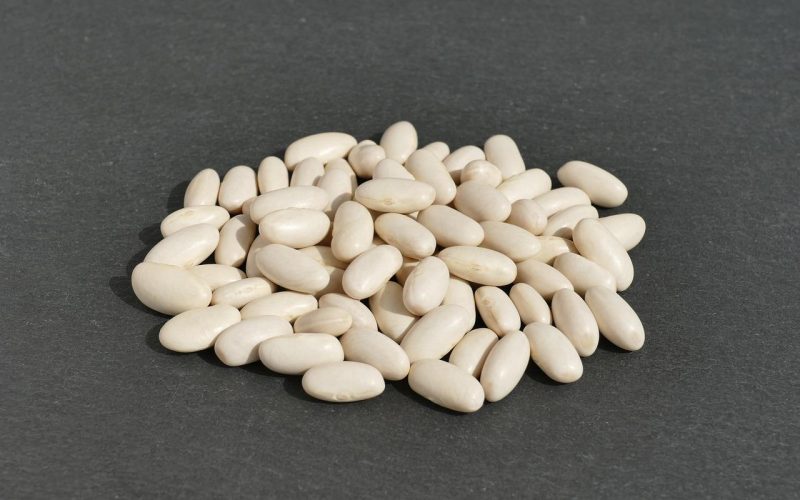If you are unfamiliar with cannellini beans, you may be familiar with them under the name “white kidney beans.
Cannellini beans are frequently used in soup, salad, and pasta dishes. Due to their mild, nutty flavor, they are extremely popular in tomato-based sauces.
Because it takes on the dish’s flavor, this bean is a fantastic complement to most dishes. When cooked, it becomes a soft bean with a faint crunch and a wonderfully fluffy texture.
Due to the bean’s widespread usage in Italian cuisine, particularly in southern and central Italy, the term “cannellini” became well-known.
It’s interesting to note that Peru supposedly originates the cannellini bean.
In the 1500s, Italian immigrants started growing beans and brought them to Europe.
Then, these delectable beans discovered their legacy in Italian cooking.
However, these beans are popular among people outside of Italy. They are a mainstay of international cuisines. In India, they are known as the labia bean and are a common ingredient in curries.
They can be used in a variety of dishes and are rather simple to make. These beans can be part of a nice lunch or supper with your friends and family and can be used for salads or cooked foods.
But what if you are unable to locate cannellini beans? The good news is that you can use a variety of substitutes for cannellini, including:
1. Great Northern Beans
Great northern beans are a prominent bean variety in North America. They have a hard shell and are grown in chilly climates.
Despite their name, these tiny and delicate beans are excellent for soups and stews because of their delicate taste.
They can nearly perfectly be used as substitutes for cannellini since they have a similar nutty flavor to Great Northern beans. However, they may require additional cooking time since their meat is harder than that of their bigger counterparts.
It has a smooth texture and flavor that pairs well with salty and sweet foods, providing a sort of balance. It also increases bulk without changing the flavor.
2. Navy Beans
A native American bean variety smaller than the wide variety of beans is the navy bean, sometimes called the pea bean. It resembles a pill since it is round and flattened. It is a component of foods, including baked beans, pies, and soups.
Due to their strong exterior and substantial meat, Navy beans require a longer boiling time. They cook more quickly and are smaller than Cannellini beans.
Navy beans are also used in fast soups and dips because they are softer. However, navy beans lose their form more quickly than Cannellini beans, so you might need to add them later than you normally would.
3. Butter Beans
Butter beans, which resemble cannellini beans and are often called small lima beans, are substitutes for cannellini. However, due to their distinct flavor and texture, they are less desirable than great northern beans.
The texture of this bean type is what sets it apart. This is how it gets its name since, when fully cooked, it has a smooth and creamy texture.
On the other hand, the cannellini bean’s texture is firmer, smoother, and less starchy. Therefore, you can use them in any recipe that calls for them without hesitation. Just be aware that they tend to thicken broths, so you might need to add extra liquid.
4. Lima Beans
Butter beans are another name for lima beans. They are a good source of protein and fiber. Additionally, they are nearly fat-free and rich in minerals, including calcium, magnesium, salt, and others.
It retains its buttery flavor and earthy taste when cooked. In soups, lima beans can substitute for cannellini beans.
Lima beans are small, though; boiling them at a high temperature can disintegrate. It is essential to boil the beans to bring out their unique buttery flavor.
5. Lentils
Lentils might not initially appear as good substitutes for cannellini beans. They are considerably smaller, have a tougher, firmer feel, and come in a wide range of colors. However, they may lend a starchy body to soups and stews that resemble cannellini beans.
Lentils taste similar to cannellini beans in terms of flavor. They pair well with savory foods and aren’t particularly sweet. Lentils are a type of grain known as a pulse, not the same as beans.
Despite this, they have a comparable nutritional profile to many beans, including a healthy amount of protein and fat.
6. Kidney Beans
Common beans come in a type called kidney beans. Their form and color resemble human kidneys, leading to their name. This bean is loaded with vitamins and minerals, including B vitamins. It is a key ingredient in Mexican, Asian, and Caribbean cooking.
Due to their size, dish texture, and cooking time similarities, kidney beans are great substitutes for cannellini beans. However, compared to the more subdued flavor of the cannellini bean, kidney beans have a more earthy, more pronounced flavor.
Unlike white cannellini beans, kidney beans are vibrant red. So, if aesthetics are important to your food, this could be your best bet. They work nicely in dishes that call for heartier tastes, such as salads, soups, dips, and chili.
7. Flageolets
Flageolets are uncommon in the United States, so don’t be shocked if you’ve never tried one. Despite being uncommon, they provide a great alternative to cannellini beans because of their comparable white color and well-known form.
Feel free to use them interchangeably in a 1:1 ratio. After trying them, you could even decide to prefer them to cannellini beans. They have a light consistency and a delicate flavor and are regarded as the “caviar of beans” in Europe.
The main disadvantage is that they could be hard to locate. However, don’t be reluctant to incorporate flageolets into your minestrone if you already have any.
8. Black Beans
When you are short of cannellini beans, black beans work well as substitutes for cannellini beans. These beans have a similar texture but are sweeter, altering how your meal looks.
These beans can frequently be substituted because they are widely accessible in supermarkets. Regarding the additional sweetness, it won’t be an issue with sweeter recipes, but you can always make up for it by adding a little extra salt or some spices to provide warmth and lessen the sweetness.
9. Pinto
Given their characteristic spotted skin and smaller sizes, you shouldn’t worry about mixing them with cannellini beans.
Even though they have a somewhat different appearance, you’ll discover they make a fantastic substitute due to their flavor and texture. Consider swapping them out 1:1.
Pinto beans are unique because of their very creamy texture. Because of this, they may be easily mashed and used for dips or refried beans. However, you should avoid using them in salads or other foods where they must maintain their form.
10. Garbanzo Beans
Chickpeas are another popular name for garbanzo beans. These beans are rich in nutrients and protein. They are incredibly adaptable, nutrient-dense foods prominent in Middle Eastern, Indian, and Mediterranean cuisines.
Chem recipes that call for breaking down cannellini beans can readily be used as a substitute.
Although they appear to have a distinct form and texture, garbanzo beans retain nutty qualities. Although they are the same color as cannellini beans, they must remove their skins before being used in their stead.
Even after soaking, it might take up to two hours to cook. They make great substitutes for cannellini beans in soups.
11. Azuki Beans
Although not in the way you may assume, azuki beans are frequently utilized in Asian cuisine. They are commonly utilized in sweets since their sweet flavor is the star.
However, if you can manage their sweetness, they can be good substitutes for cannellini beans.
When you substitute cannellini beans for them, be careful to add vinegar and a little salt to counteract their sweetness. This will enhance the nutty qualities, making them unexpectedly reminiscent of cannellini.
You should use azuki beans in stews with robust, rich tastes because they also tend to be squishy. However, their softness does make cooking them without soaking them first possible.
12. Marrow Beans
Small, white marrow beans boast a mild yet distinct flavor that intriguingly mimics the savory taste of salty bacon.
Much like their legume counterparts, these beans feature a rich, buttery, and creamy texture akin to that of Cannellini beans.
Their delicate taste and luxurious mouthfeel make them a versatile ingredient, perfect for enhancing soups, stews, and casseroles.
Additionally, they pair wonderfully with various herbs and spices, allowing them to integrate seamlessly into various culinary creations.
Whether you want to add depth to a hearty dish or seek a nutritious addition to your meal, marrow beans are a delightful choice.
13. Soy Beans
Contrary to popular belief, soybeans don’t share as many characteristics as other beans regarding texture and flavor.
They are smooth and solid and have a comparable sharpness to garbanzo beans. They can be an excellent final choice, even if they might not be the best substitute for cannellini beans.
It has a very subtle flavor, especially after cooking. This taste, together with their firm structure, makes them a terrific option for salad. They tend to stand out in a stew since they don’t absorb flavors like other beans.
14. Borlotti Beans
Stop looking if you can get these beans at your neighborhood shop or already have them at home. The most beautiful, vivid beans you will ever see are borlotti beans.
These beans’ delicate rose hue will add beauty to any cuisine. Although they have Colombian origins, they are frequently utilized in Italian cuisine.








